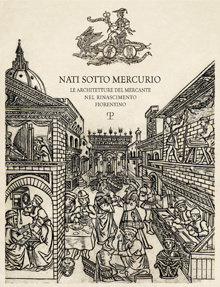Ricerca Veloce
Ricerca Avanzata
chiudi
This book is a collection of three essays that address the architecture used by Florentine merchants throughout the fifteenth and sixteenth centuries
This book is a collection of three essays that address the architecture used by Florentine merchants throughout the fifteenth and sixteenth centuries. The volume is the result of a larger project promoted by the Italian Ministry of Education called Il palazzo del mercante, la bottega, i siti della mercatura tra Medio Evo ed Età Moderna, under the supervision of Maria Serena Donatella Calabi. This study is centered upon four Italian cities – Turin, Venice, Florence, and Rome – and, as the title suggests, it focuses specifically upon the spaces used by the merchant during the Renaissance: his house, his shop, the marketplace, and the commercial streets and squares where business functions were concentrated. A group of local scholars has been appointed to develop the research in each of these cities. Aside from monographic studies of certain families or buildings, no previous attempts have been made to address the broader scope that this volume embraces. Although this is not a complete history of mercantile architecture – which will be the goal of the second phase of this national project – it is a remarkably welldocumented study. In fact, one of the strongest achievements of the volume is the great quantity of archival documents that it cites, including census records, tax registers, private inventories, and guild regulations. Of particular interest is the 1561 census of Florentine shops and homes under Cosimo I, which is an extraordinary tool that allows us to reconstruct how merchants used their residential and commercial spaces: for example, depending upon the kind of shop and the wealth of the owner, he and his family could live upstairs, in a different building, or even in the shop itself. It is also possible to trace changes in the architectural style of palaces owned by wealthy Florentine merchants. While at the beginning of the fifteenth century shops on the ground floor had a positive connotation – linked with the status of the owners and the income that such shops provided – later on the same families preferred to hide the commercial origin of their wealth and emphasize their new status in the city government or in the ducal court. The large amount of archival material consulted by the authors allows for better definitions of specific spaces such as the scrittoio, the merchant’s most private office room. In addition, in order to better understand the daily life of these spaces, references to contemporary literature have been included, such as Sacchetti’s Trecentonovelle, Cavalcanti’s Istorie Fiorentine, and Machiavelli’s works, in which many characters are described in the everyday use of commercial and domestic spaces. In the first essay, Gianluca Belli analyzes the Florentine situation during the fifteenth century, dividing the city into different functional areas. The basis for this study is the data from the census records, in which shop owners are listed with their merchandise and their possessions. Not surprisingly, we find that the commercial districts in Renaissance Florence were not different from the ones we see today. In the second essay, dedicated to the sixteenth century, Amedeo Belluzzi takes a different approach: he defines several centers of varied mercantile activity in Florence, focusing on the rich relations between different functions and typologies of trade. Both Belli and Belluzzi succeed in reconstructing key commercial centers of the city in all their functions and original architecture, including the no-longer extant Mercato Vecchio. In the final essay, Donatella Battilotti focuses on the two main industries of Florence: wool and silk. She illustrates how the different phases of production were interconnected with one another and identifies their specific locations within the city, as well as in the immediate vicinity. On the whole, this volume offers an expansive view of mercantile life in Renaissance Florence. For the first time, a vast range of archival documents is used to link the homes of themerchants with their shops and to study the commercial spaces on a broader urban scale. Although the individual deductions of each author are illuminating, no common conclusions have been drawn from the three essays as a whole: this may perhaps be addressed in the future as this project continues to expand.
Data recensione: 01/10/2012
Testata Giornalistica: Renaissance Quarterly
Autore: Lorenzo Vigotti
